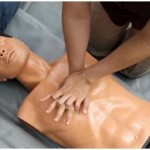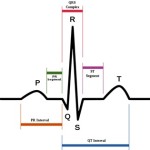Atrial Flutter is a common abnormal heart rhythm. Atrial Flutter is very similar to atrial fibrillation. In most cases the atrial fibrillation is considered as the most common abnormal heart rhythm. The atrial flutter and the atrial fibrillation are types of supraventricular tachycardia. In AFL the upper chambers (atria) of the heart beat very fast, this can give a result to the atrial muscle contractions that are much faster and out of sync with the lower chambers (ventricles).
So What is Atrial Flutter?
First you have to know that the electrical system of the heart is the power source that makes the heart-beat. The electrical impulses travel along a pathway in the heart and make the upper and the lower chambers of the heart (atria and the ventricles) work together to pump blood through the heart.
 A normal heartbeat begins as a single electrical impulse; this electrical impulse comes from the sinoatrial (SA) node, a small bundle of tissue located in the right atrium. This impulse that is located in the right atrium sends out an electrical pulse that causes the atria to contract (squeeze) and move blood into the lower ventricles. From this point the electrical current passes through the atrioventricular (AV) node. This is the electrical bridge between the upper and lower chambers of the heart that causes the ventricles to squeeze and release, they draw the blood into the heart and push it back out to the rest of the body. The path that the electrical impulse passes and the information that this impulse sends is the main cause of the pulse we feel on our wrist or neck.
A normal heartbeat begins as a single electrical impulse; this electrical impulse comes from the sinoatrial (SA) node, a small bundle of tissue located in the right atrium. This impulse that is located in the right atrium sends out an electrical pulse that causes the atria to contract (squeeze) and move blood into the lower ventricles. From this point the electrical current passes through the atrioventricular (AV) node. This is the electrical bridge between the upper and lower chambers of the heart that causes the ventricles to squeeze and release, they draw the blood into the heart and push it back out to the rest of the body. The path that the electrical impulse passes and the information that this impulse sends is the main cause of the pulse we feel on our wrist or neck.
With AFL, the electrical signal can travel along through a pathway within the right atrium. It moves in an organized circular motion, causing the atria to beat faster than the ventricles of your heart. AFL is a heart rhythm disorder that is similar to the more common atrial fibrillation. The AFL can cause the heart to beat faster and in no regular pattern or rhythm. With AFL, the heartbeat is faster, but in a regular pattern. This is fast, but regular pattern of AFL is what makes it more special. AFL makes a very distinct pattern on an electrocardiogram (ECG), a test used to diagnose abnormal heart rhythms.
Risk factors
Some medical conditions are increasing the risk for developing an AFL. These medical conditions include:
- Heart failure
- If you had a previous heart attack
- Valve abnormalities or congenital defects
- People that suffer from high blood pressure
- A recent surgery
- Dysfunction of the thyroid
- Alcohol abuse
- Chronic lung disease
- A sever acute illness
- Diabetes
Symptoms of Atrial Flutter
The electrical signal that causes the atrial flutter circulates in an organized, but very predictable pattern. This organized and predictable pattern means that people with atrial flutter usually continue to have a steady heartbeat, even though it is faster than normal. There are chances that people with AFL may feel no symptoms at all. Other symptoms are:
- Hearth palpations
- Fast steady pulse
- Shortness of breath
- Trouble with everyday exercises or activities
- Pain, pressure, tightness or discomfort in your chest
- Dizziness, lightheadedness, or fainting
Complications
Atrioventricular flutter is not threatening. If you don’t treat it, the side effects of AFL can make it harder for the heart to pump blood effectively. The blood moves very slowly and forms clots on its way. The already formed clot is pumped out of the heart and this clot can travel to the brain and lead to a stroke or heart attack.
Without a proper treatment, AFL can cause a fast pulse rate for long periods of time. A fast pulse rate for long periods of time means that the ventricles are beating too fast. When the ventricles are beating too fast for long periods of time, the heart muscle becomes weaker. This condition of weak hearth muscle is called cardiomyopathy. Cardiomyopathy can lead to heart failure and long-term disability.
With no treatment, AFL can also cause another type of arrhythmia called atrial fibrillation. This type of arrhythmia is the most common type of abnormal heart rhythm.
Atrial Flutter Treatment
Most people that have atrial flutter take prescribed medications. They have to avoid any kind of stimulants that have previously provoked the atrial flutter, which means that they have to consult their health care provider before any new medications, herbs or supplements they take.






















